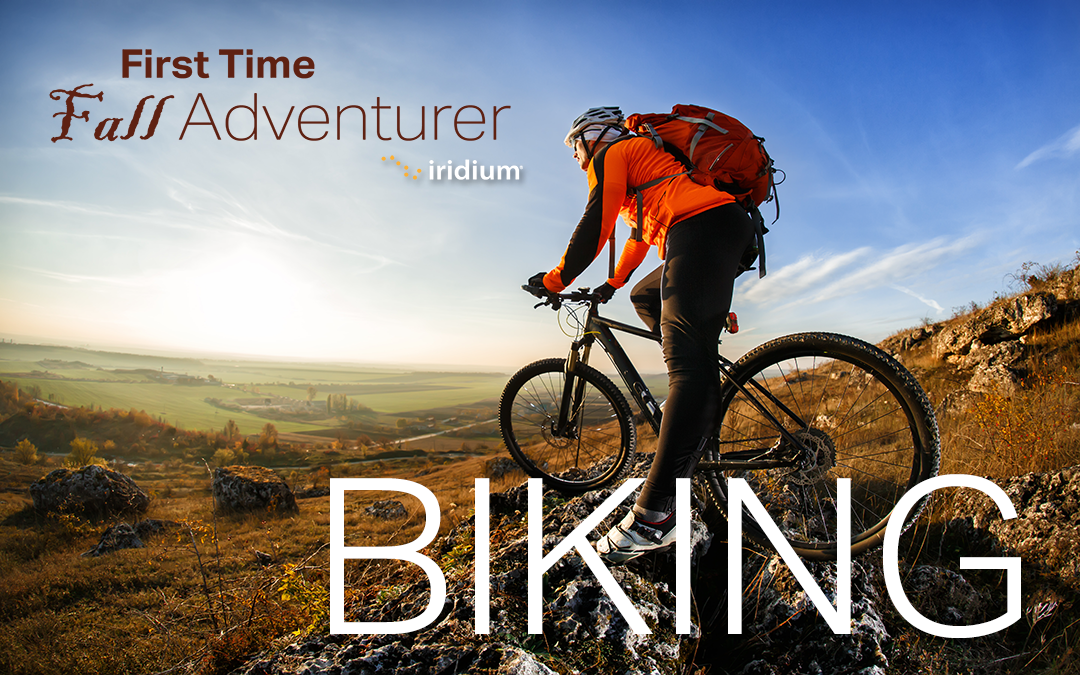First-Time Adventurer: Biking

Join us this Fall in getting out and trying new adventures! Not sure where to start? We’ve got some tips for you.
With the holidays and winter rapidly approaching, now is the perfect time to get out and take advantage of the cool crisp air before it gets too cold to enjoy! In this installment of our First Time Fall Adventurer series, learn what to consider before heading out on a bike trip!
Select Your Terrain
- Singletrack is the most common trail type. Its width ranges from just a little wider than your shoulders to a track that’s wide enough for two bikes to pass each other. Many singletrack trails are open to one-way travel and wind their way through beautiful views.
- Doubletrack trails are usually twice the width (or more) of a typical singletrack trail, giving you enough space for two bikes to ride next to each other. Often these trails were created by vehicle tires, meaning that this type of trail may follow along abandoned logging roads, fire roads, or power-line roads. These trails also usually have a gentler grade than singletrack, which may make it best for beginner bikers.
- Mountain bike terrain parks are a fun and increasingly common trail type – appearing everywhere from under urban overpasses to ski resorts. This trail type often has features like elevated bridges, halfpipes, jumps of various sizes, berms, banked corners and hairy downhill switchbacks.
Determine your Biking Style
- Trail:This is the most common mountain biking style – and considered “the fun one”! If you want to bike with friends or try out different climbs and descents, this biking style is perfect for you.
- Cross-Country: This style of riding typically implies riding fast, with an emphasis on climbing. This is a great biking type if you’re thinking about getting involved in competitive biking or just want a more adventurous ride.
- All-Mountain/Enduro:This type of biking is similar to trail riding, but is much more intense! Think of leg-burning climbs, white-knuckle descents, and more technical features—both man-made and natural.
- Downhill/Park:This type of riding is mostly available at lift-serviced bike parks. You ride tough bikes and wear full-face helmets and body armor as you ride over jumps, berms, rock gardens, and wooden ladders – and you’re descending the whole time! There’s not much pedaling since gravity does the work, but you’ll still get a great workout since you’re constantly reacting to the terrain!
Pick Your Bike
- Rigid: Rigid bikes are easy to maintain and usually less expensive, but don’t have any suspension, which some riders find uncomfortable. Some riders choose rigid “fat bikes” which have wide tires and low pressure to absorb bumps in the trail.
- Hardtail: These bikes have suspension that absorbs impact on the front wheel, but the rear has no suspension, giving this type of bike its name – hardtail. These bikes tend to be less expensive than full-suspension bikes, and have fewer moving parts, meaning they require less maintenance. Most hardtail bikes also have the ability to lock the front suspension fork, allowing you to turn it into a rigid bike when desired.
- Full Suspension:This type of bike is built to absorb the impacts of the trail, reducing the impact on your body, increasing traction, and making for a more enjoyable ride.
Learn more about what to consider and how to pick the best bike for you by clicking here.
Safety First
- Trail bike rides usually take longer than you think, especially on trails with more rugged terrain. Make sure to pack more food and water than you think you need.
- Make sure to carry the tools you may need – a spare tube, a hand pump, and a small multi-tool.
- You might not have cell phone service on the trails if you need help or encounter a medical emergency. It’s a smart idea to bring a satellite-enabled emergency device. Many Iridium partners offer small devices that work anywhere on the planet – even in places where your cell phone won’t connect. There are several Iridium Connected options, ranging from simple one-way emergency SOS devices, to small two-way communications device with SMS texting features and maps. Click here to browse our partner products and find a local retailer who can help you through your purchase.

